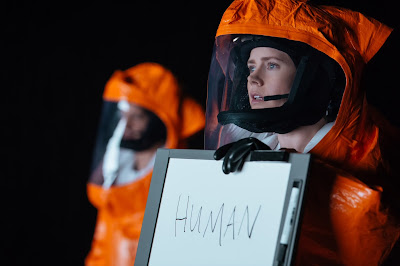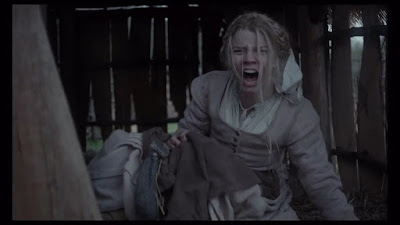LACK OF PACE KILLS
Film Review by Fiore
 ALLIED is a dual speed film, beginning with
a brisk rabbit pace and concluding in a tortoise crawl. The contrast is stark, transforming what could have been a cinematic
tour de force to a mundane tale.
ALLIED is a dual speed film, beginning with
a brisk rabbit pace and concluding in a tortoise crawl. The contrast is stark, transforming what could have been a cinematic
tour de force to a mundane tale.
In 1942, a
Royal Canadian Air Force spy, Max Vatan, played by Brad Pitt, is dropped in the
desert just outside of Casablanca for a covert mission to assassinate a German
ambassador. The viewer is never told why
this particular ambassador is targeted, nor why the protagonist is
Canadian. Since World War II is
considered one of America’s greatest victories, perhaps this was a method of
inclusion, showing other countries contributed as well. Needless, but it would fit in with the
current Hollywood concept of not praising the country. Brad Pitt is commanding on screen. Regardless of the part, he always brings a
certain je ne sais quoi to his performances, even when the characters are
mundane. His hair coloring and attire
make him look very much like Robert Redford when he portrayed Jay Gatsby.
Max’s
contact, and co-conspirator in the assassination, is Marianne Beausejour,
played by Marion Cotillard, who is a notorious member of the French
Resistance. While they meet, and
schmooze their way among Casablanca’s elite, they never stop at Rick’s Café,
exchange banter with Louie or sing “As
Time Goes By”. Pity. Cotillard has a rough-Earth beauty; she is
simultaneously commonplace, yet mesmerizing.
She and Pitt play off each other well.
KEY SCENES TO LOOK FOR:
1.
THE SAND STORM
2.
THE AIR RAID
3.
GIVE ME A
GRENADE
This first
half of the story shows well. It is
fast-paced, energetically shot and contained with succinct dialogue. Once Max and Marianne’s suicide mission is
complete, the scene shifts to London, and the tale begins to slog.
At this
point in ALLIED, inconsistencies in the story become rampant. Since Max is a member of the Canadian Air
Force, why does he return to London and not Canada? Why does Marianne, who is supposedly ruthless,
demonstrate extreme charity before leaving Casablanca? Why is Max’s sister living in London, instead
of Canada? How is it she is a lesbian,
and conducts an openly homosexual relationship in London at a time when
homosexuals were incarcerated and put to death?
Why is Max’s wardrobe so similar to today’s style of mixing stripes and
checks, when the fashion of the day was much more sensible? Apparently, after making love, men in
Casablanca sit on their rooftops. There
are four such scenes in ALLIED, yet in each, Max is the only
man on a roof. What caused all the other
women in Casablanca to turn frigid?
Obviously, these questions reveal Screenwriter Stephen Knight, as is his
penchant, needs to insert the agenda into his script, even when it is obviously
revisionist history and detracts tremendously from the story.
 After
returning to London, Max and Marianne develop a relationship despite warnings
from his superiors, marry and raise a family.
When all seems idyllic, Max is informed his wife may be a double agent,
and the second half of the film centers on his discovery of the truth. While the concept is stellar, the film drags
in the second plot unfolding, with long sequences for minor plotpoints and near
impossible timeline occurrences. Where
the Casablanca setting offers a compelling espionage tale, the London setting
plays as if it were a John LeCarre omnibus.
After
returning to London, Max and Marianne develop a relationship despite warnings
from his superiors, marry and raise a family.
When all seems idyllic, Max is informed his wife may be a double agent,
and the second half of the film centers on his discovery of the truth. While the concept is stellar, the film drags
in the second plot unfolding, with long sequences for minor plotpoints and near
impossible timeline occurrences. Where
the Casablanca setting offers a compelling espionage tale, the London setting
plays as if it were a John LeCarre omnibus. The
production design team of Gary Freeman and Raffaella Giovannetti do a superb
job of recreating the look of the 1940’s.
Alan Silvestri scores a moving soundtrack befitting the period. Robert Zemeckis orchestrates the opus, and
frankly I’m rather surprised he allowed the film to slow so much in the second
half. Perhaps part of the problem is
utilizing an editing team. I’m not a fan
of more than one editor on a film; I believe it clouds the vision. Regardless, Zemeckis is not known for braking
his workflow.
The
production design team of Gary Freeman and Raffaella Giovannetti do a superb
job of recreating the look of the 1940’s.
Alan Silvestri scores a moving soundtrack befitting the period. Robert Zemeckis orchestrates the opus, and
frankly I’m rather surprised he allowed the film to slow so much in the second
half. Perhaps part of the problem is
utilizing an editing team. I’m not a fan
of more than one editor on a film; I believe it clouds the vision. Regardless, Zemeckis is not known for braking
his workflow.
ALLIED, like so many other films that are
high ranking contenders for awards this year, is worth a look, but certainly
not worth repeated viewings. Had the
London escapade kept pace with Casablanca, ALLIED could very possibly have been
one of the year’s best.
THE GRADE FOR ALLIED = C








